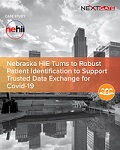 By David Bennett, Regional Director, NextGate
By David Bennett, Regional Director, NextGate
Twitter: @NextGate
Many of the nation’s statewide health information exchanges (HIEs) have struggled for sustainability since the early 2000s – but not in Nebraska. The Cornhusker State has seen great success with its efforts to connect health systems, physician offices, and public health entities.
That’s because CyncHealth (formerly known as NEHII) has always seen itself as more than just a network of pipes to shuttle data from one place to another. Instead, with the help of strong leadership and collaborative technology partners, CyncHealth has worked to become a true population health utility for all Nebraskans.
At a recent presentation to the Texas-based Healthcare Think Tank, CyncHealth’s CEO, Jaime Bland, DNP, RN, explained what it means to be a health data utility and how Nebraska’s approach to data exchange has equipped it to tackle COVID-19.
“Our goal is to integrate payers, providers, and other data sources into a health information exchange architecture that makes sense for understanding how healthcare outcomes impact our communities,” said Bland.
“You’ll hear us call ourselves a ‘population health utility’ or ‘health data utility’ because we are building the roads and the infrastructure for better workflows and better patient care, not just improved data exchange,” she said. “The goal is to create a zero-click environment where the data is simply available to end-users without extra burdens in the workflow. We’re committed to delivering on the promise of health information technology, because we can’t afford to fail.”
CyncHealth works with industry partners, including NextGate, Salesforce, and others, to support a range of innovative functionalities for care coordination, population health management, and prescription drug management.
With broad buy-in from health systems, labs, and other providers across the state, it was a natural extension of CyncHealth’s mission to spearhead Nebraska’s rapid COVID-19 response, added Kevin Conway, Data Integrity Manager at CyncHealth.
“We ingest a number of data sources to create longitudinal views of records for individuals, with many of the data sources available in real-time,” Conway said. “We have nearly instantaneous access to admission, discharge, and transfer (ADT) notifications and lab messages that come into our base HIE platform, and we also administer the state’s prescription drug monitoring program (PDMP).”
Nebraska’s health data environment is unique in several ways. Firstly, the state’s PDMP includes all medications dispensed to patients, not just controlled drugs. And since many public and private labs both participate in CyncHealth, researchers and public health officials can use a variety of clinical indicators to examine some of the underlying factors that may contribute to the severity and outcome of COVID-19 in specific groups.
“With all this data, it was a relatively easy pivot to create a command center to coordinate the state’s pandemic response activities,” Conway said. “We actually stood up our first feature, the bed capacity dashboard, within three weeks.”
The bed capacity dashboard provides a real-time look at ICU bed availability and overall bed utilization across Nebraska’s healthcare systems. This helps providers and officials understand patterns in disease prevalence and how to allocate scarce resources quickly and efficiently, noted Bland.
“The governor couldn’t have this fast enough, and we’ve been asked to demo it for numerous organizations, including the highest levels of HHS and the White House COVID-19 Task Force,” she said. “Combined with our other data dashboards and predictive analytics tools, it has been really critical for our response across the state.”
None of this would be possible without clean, reliable, and accurate patient matching and identity verification, Conway stressed.
“We have to make sure that we can match patients appropriately when bringing in disparate data sources, generating records, and conducting analytics,” he stated. “There are so many small issues that can cause big problems for data aggregation. There are typos all over the place. Some people switch the order in which they enter first names and last names; sometimes dates are missing or incorrect.”
“We rely on our foundational technology systems to identify and overcome these issues so that the data is as clean and consistent as possible. We always need to make sure that the data is matched correctly to the right individual and that any lab tests and medications are tied to the right person. Any mismatches are critical and could lead to patient safety issues. Obviously, we need to avoid that.”
CyncHealth will continue to enhance its COVID-19 tools for as long as is necessary, but the population health utility hasn’t lost sight of its concurrent goals to foster better care and improve outcomes for all populations under its care.
A recently announced strategic partnership with the Iowa Health Information Network (IHIN) has expanded its purview and given leaders in both states the chance to collaborate on their shared goals.
“As clinicians and technologists, we know that we can do hard things,” Bland said. “We know that we’re going to get to that smallest last mile of interoperability and pull everyone into a network that will produce benefits for patients.”
“Collaboration is essential to meet our goals. When we bring together a lot of smart, dedicated people, we can achieve the vision of becoming a population health utility that is as simple and reliable as turning the lights on.”
This article was originally published on the NextGate Blog and is republished here with permission.
Case Study: NEHII Rises to the Challenge of COVID-19 with Cloud-Based Analytics and Robust Patient Matching Tools
 NEHII partnered with NextGate to accurately match and connect critical public health information across the state of Nebraska to support trusted data exchange and case reporting for COVID-19 using an Enterprise Master Patient Index on Amazon Web Services (AWS).
NEHII partnered with NextGate to accurately match and connect critical public health information across the state of Nebraska to support trusted data exchange and case reporting for COVID-19 using an Enterprise Master Patient Index on Amazon Web Services (AWS).
COVID-19 has affected nearly every community in the United States, creating a significant challenge for healthcare leaders looking to coordinate their actions at the local and regional level. Fortunately, in states like Nebraska, state-level health information exchanges (HIEs) are stepping up to use their infrastructure to support rapid, effective public health interventions.
With advanced cloud-based infrastructure from AWS and a reliable, secure enterprise master patient index (EMPI) from NextGate Solutions, Nebraska Health Information Initiative (NEHII) is providing critical insights to inform COVID response activities for those affected by the virus.
